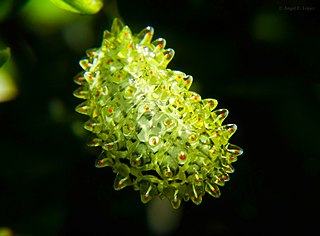Oroya aurora is a moth in the family Dalceridae, and the only species in the genus Oroya. Both the genus and the species were first described by Scott E. Miller in 1994. It is found in southern Peru and adjacent Bolivia. The habitat consists of tropical premontane wet, tropical premontane moist and subtropical (lower) montane wet forests.
Acraga goes is a moth of the family Dalceridae. It is found in Costa Rica, Ecuador, Venezuela, Trinidad, Guyana, Suriname, French Guiana, Colombia, Peru and Brazil. The habitat consists of tropical wet, tropical moist, tropical dry, tropical premontane wet, tropical premontane moist and subtropical dry forests.
Acraga andina is a moth of the family Dalceridae. It is found in Andes Mountains of Venezuela, Colombia, Ecuador and Peru. The habitat consists of tropical wet, tropical premontane wet, tropical premontane moist and probably tropical montane wet forests.

Acraga coa is a moth of the family Dalceridae. It is found in southern Mexico, Belize, Honduras, Guatemala, El Salvador, Costa Rica and Panama. The habitat consists of tropical wet, tropical moist, tropical premontane wet, tropical premontane rain, tropical lower montane moist, subtropical wet, subtropical moist, subtropical dry and warm temperate wet forests.
Acraga concolor is a moth from the family Dalceridae. It is found in Venezuela, Suriname, French Guiana, northern Brazil, Ecuador, Peru and Bolivia. The habitat consists of tropical moist, tropical wet, tropical premontane rain, tropical premontane wet and subtropical moist forests.
Acraga citrinopsis is a moth of the family Dalceridae. It is found in Venezuela, Brazil, Peru and Bolivia. The habitat consists of tropical moist, tropical dry, tropical premontane moist, subtropical moist and warm temperate moist or dry forests.
Acraga beebei is a moth of the family Dalceridae. It is found in northern Venezuela. The habitat consists of tropical premontane moist forests.
Acraga meridensis is a moth of the family Dalceridae. It is found in the Andes Mountains of Venezuela and Colombia. The habitat probably consists of tropical premontane and lower montane moist or wet forests.
Acraga mariala is a moth of the family Dalceridae. It is found in Colombia. The habitat consists of tropical lower montane or premontane wet and tropical lower montane moist forests.
Acraga perbrunnea is a moth of the family Dalceridae. It is found in Colombia and Peru. The habitat consists of tropical lower montane moist and tropical premontane wet forests.
Acraga citrina is a moth of the family Dalceridae. It is found in Trinidad, Venezuela, Guyana, Suriname, French Guiana and northern Brazil. The habitat consists of tropical moist, tropical dry, tropical premontane moist and tropical premontane dry forests.
Acraga puno is a moth in the family Dalceridae. It was described by S.E. Miller in 1994. It is found in southern Peru. The habitat consists of tropical moist and tropical premontane wet forests.
Dalcerides sofia is a moth in the family Dalceridae. It was described by Harrison Gray Dyar Jr. in 1910. It is found in southern Mexico, Guatemala, El Salvador, Nicaragua and Costa Rica. The habitat consists of tropical moist, tropical dry, tropical premontane wet, subtropical moist, subtropical dry and warm temperate wet forests.
Dalcerides dulciola is a moth in the family Dalceridae. It was described by Harrison Gray Dyar Jr. in 1914. It is found in southern Mexico, Costa Rica, Panama, northern Ecuador and northern Venezuela. The habitat consists of tropical wet, tropical moist, tropical premontane wet and tropical premontane rain forests.
Dalcerides flavetta is a moth in the family Dalceridae. It was described by Schaus in 1905. It is found in Venezuela, Guyana, Suriname, French Guiana, Colombia, Ecuador, Peru, Bolivia and northern Brazil. The habitat consists of tropical wet, tropical moist, tropical premontane wet, tropical premontane moist, subtropical moist and tropical dry forests.
Minacraga disconitens is a moth in the family Dalceridae. It was described by Schaus in 1905. It is found in Venezuela, Trinidad, Guyana, Suriname, French Guiana, Brazil, eastern Peru and Bolivia. The habitat consists of tropical moist, tropical premontane wet, tropical premontane moist, subtropical moist and warm temperate moist or dry forests.
Minacraga argentata is a moth in the family Dalceridae. It was described by Walter Hopp in 1922. It is found in Colombia, eastern Brazil and Peru. The habitat consists of tropical wet, moist and premontane wet forests.
Paracraga argentea is a moth in the family Dalceridae. It was described by Schaus in 1910. It is found in Mexico, Honduras, Belize, Guatemala, El Salvador, Costa Rica and Panama. The habitat consists of tropical wet, tropical moist, tropical premontane wet, tropical premontane moist, subtropical wet subtropical moist forests.
Paracraga canalicula is a moth in the family Dalceridae. It was described by Paul Dognin in 1910. It is found in Colombia and Peru. The habitat consists of tropical wet, tropical moist and tropical premontane wet forests.
Minacraga plata is a moth in the family Dalceridae. It was described by S.E. Miller in 1994. It is found in Costa Rica and Panama. The habitat consists of tropical moist, tropical premontane wet and tropical premontane moist forests.
